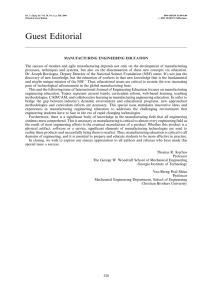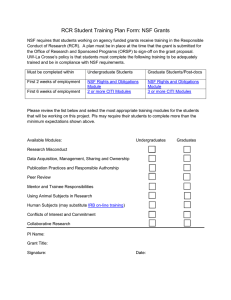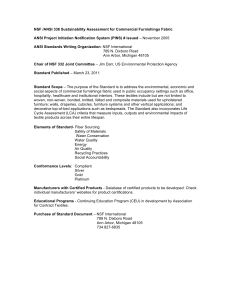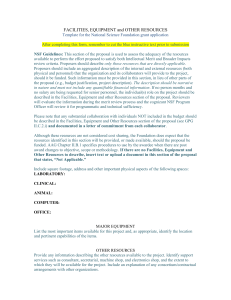NATIONAL SCIENCE FOUNDATION FACILITIES MANAGEMENT AND OVERSIGHT GUIDE PURPOSE
advertisement
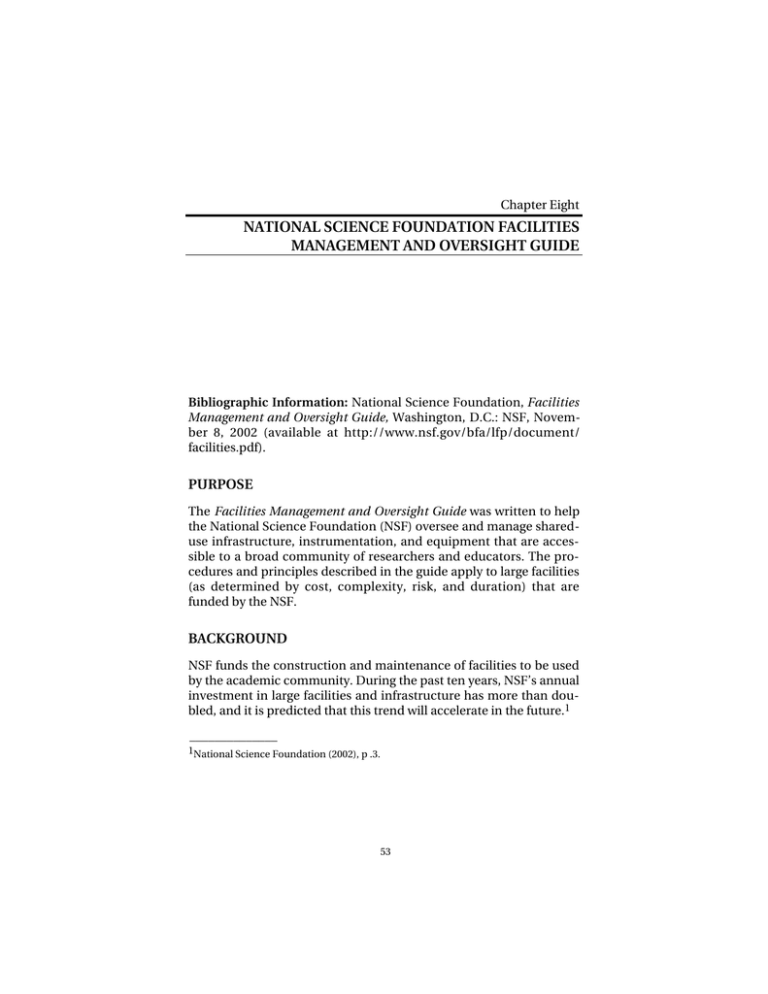
Chapter Eight NATIONAL SCIENCE FOUNDATION FACILITIES MANAGEMENT AND OVERSIGHT GUIDE Bibliographic Information: National Science Foundation, Facilities Management and Oversight Guide, Washington, D.C.: NSF, November 8, 2002 (available at http://www.nsf.gov/bfa/lfp/document/ facilities.pdf). PURPOSE The Facilities Management and Oversight Guide was written to help the National Science Foundation (NSF) oversee and manage shareduse infrastructure, instrumentation, and equipment that are accessible to a broad community of researchers and educators. The procedures and principles described in the guide apply to large facilities (as determined by cost, complexity, risk, and duration) that are funded by the NSF. BACKGROUND NSF funds the construction and maintenance of facilities to be used by the academic community. During the past ten years, NSF’s annual investment in large facilities and infrastructure has more than doubled, and it is predicted that this trend will accelerate in the future.1 ______________ 1National Science Foundation (2002), p .3. 53 54 A Review of Reports on Selected Large Federal Science Facilities The NSF currently provides support for facility construction from two major accounts. One account, the Research and Related Activities account, has traditionally been used to fund the planning, design, development, operations, and maintenance of all facility projects, but is currently used to support only smaller projects whose costs range from millions to tens of millions of dollars. The other account, the Major Research Equipment and Facility Construction account, was established in fiscal year 1995 to separately fund the acquisition and construction of large facility projects, the costs of which are on the order of tens of millions to hundreds of millions of dollars. Given NSF program officers’ extensive involvement in nearly every stage of these projects, it is essential that they remain aware of and sensitive to the issues and challenges that are likely to arise along the way toward completion of a project. Documented requirements and procedures for dealing with large facilities projects exist and are laid out in detail in the NSF guide. METHODS/APPROACH Drawing on the existing formal procedures for all NSF awards and generally accepted principles of project management, this guide lays out in detail all of the procedures and best practices associated with the management and oversight of a facility project. The best practices described in the guide were gathered from the NSF, NSF awardees, and NSF federal agency partners. The guide organizes this information according to the five facilitylife-cycle stages: concept, development, implementation, operations and maintenance, and renewal or termination: • Concept Stage: The idea for a facility is articulated and project planning and design begin. • Development Stage: Project planning and design are completed, and the proposal is submitted. • Implementation Stage: Awardee Project Execution Plan is completed and implemented by the awardee and overseen by the NSF. National Science Foundation Facilities Management and Oversight Guide 55 • Operations and Maintenance Stage: The facility is used for its intended purpose. • Renewal or Termination Stage: Decisions are made regarding continued support of a facility. 2 FINDINGS AND RECOMMENDATIONS The guide’s discussion of the procedures that NSF oversight and management staff follow emphasizes specific issues. In presenting these issues, the guide • highlights the requirement that the project awardee must submit a comprehensive Project Execution Plan that provides a clear statement of what will be done and how it will be accomplished • prescribes a comprehensive Internal Management Plan that describes how the NSF will manage the agency side of the project • describes a new position within the NSF to (1) help manage and oversee the large-project technical and business staff, (2) review Internal Management Plans, and (3) help transmit lessons learned and best practices to NSF program officers • describes a new position within the NSF to help manage and oversee the large-project portfolio—the Large Facility Project (LFP) Deputy within the Office of Budget, Finance, and Award Management. The role of the LFP Deputy will be to enable consistent management and oversight of all large projects, including all business and financial aspects. • emphasizes the need for consistent and effective use of Project Advisory Teams to advise program officers on business, financial, and legal matters, and other related aspects of projects and project management.3 The roles and responsibilities of NSF staff, awardees, and the science and engineering community, and the detailed procedures and best ______________ 2See National Science Foundation (2002), Table 2, p. 6, for a detailed description of the activities at each stage. 3National Science Foundation (2002), p. 4. 56 A Review of Reports on Selected Large Federal Science Facilities practices associated with those roles and responsibilities, are laid out within the guide’s framework of a facility’s life cycle.4 The guide specifically recommends that the NSF • increase its focus and awareness on strong project management and oversight principles • clearly state the policies, procedures, and requirements that come into play at each stage of the facility project—throughout its life cycle • document the experience, knowledge, and best practices gained over many years to facilitate a process of continuous improvement, based on the learning of best practices • introduce consistency among the various projects at NSF, with the ultimate goal of reducing the need to relearn valuable lessons about management and oversight. The guide also discusses seven other special topics in detail: NSF review and approval and the federal budget process, budgeting and funding, risk assessment and management, documentation, oversight reviews and reporting, partnerships, and operating budgets. Some of these topics are summarized in the guide in terms of their implications at each stage of a facility’s life cycle. 5 ______________ 4See National Science Foundation (2002), p. 13, for descriptions of the general roles throughout the oversight of LFPs. 5See National Science Foundation (2002), Table 3, p. 11; Table 4, p. 37; Table 5, pp. 39– 40; and Table 6, pp. 42–44.



